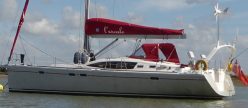Wednesday 30 May
Although tempted to stay another day, and explore the local national park with our new friends, Desiré’s crew, we decided to press on, and were away earlier than planned as the survey vessel berthed opposite started their day none too quietly around 0500. Heading out down the channel, Mate discovered the chart plotter wasn’t willing to wake up this early either – yet another victim of lightning? Skipper twiddled and fiddled and did what he does best, and eventually discovered that somehow the brightness had been turned down to zero, so the screen was blank.
Having sorted out that almost catastrophe, Mate put the radar through its paces as we made our way through yet another early morning fog bank – beginning to get regular senses of déja vu here. We narrowly missed a fishing net stake, because they are often fitted with a radar reflector, which ours saw long before Mate did, and she also changed course to avoid a much larger ‘blob’ on the display, with no corresponding mark on the chart. It turned out to be a large yellow buoy carrying a solar panel, maybe a weather station or a remote data collection point for some other kind of scientific research.
Once we’d cleared through the fog, it was another day of sunshine in a clear blue sky, but the persistent N/NE wind was still cold, limiting opportunities for sunbathing on passage. The chart indicated that we were nearing the TSS (Traffic Separation Scheme, a kind of two-lane highway for traffic into major ports that yachts should keep well clear of) into the Gulf of Gdansk, and the fact that we could see ships that weren’t showing on our chart plotter confirmed that, as well as not transmitting VHF or AIS, we were now not receiving AIS reliably either – definite electronics sabotage by storms. Thank goodness we carry a resident electronics expert on board – he sat at the chart table clipping and twisting bits of wire until he’d got everything back in full working order, without having to go up the mast again to dismantle the aerial.
At lunchtime the wind dropped to nothing, and it felt much warmer. However, it proved to be just a lull, and by early afternoon the genoa was unfurled and the engine turned off, and we had a lovely sail along a slightly more interesting stretch of the Polish coastline, past the seaside resort of Władysławowo, nicknamed ‘Gladys’s Volvo’ by my tongue-twisted crew. Sandstone cliffs rise attractively behind white sandy beaches to give structure to a long spit of sand dunes that reaches across the NW tip of the Gulf of Gdansk.
Having received no berthing instructions when we radioed into port for permission to enter, we found most of the finger pontoons in the yacht harbour empty, and helped ourselves – in a difficult crosswind that made for a challenging manoeuvre. Yet again, just as we were secured and tidied up, the bosman came along shaking his head “nooo, you’re too big and heavy, pontoons not strong enough…” and indicated we should take a berth on the adjacent quay wall – where we were charged 80 PLN (zlotys), the highest fee so far in Poland: £16. Oh, and where were we? Just around the corner of the end of the sand spit – in Hel.
For the first time since we crossed the border from Germany, Polish border police in the form of a pretty young blonde in combat fatigues, soon arrived with a polite smile and a few routine questions. Obviously satisfied with our answers, she wished us a pleasant stay.
